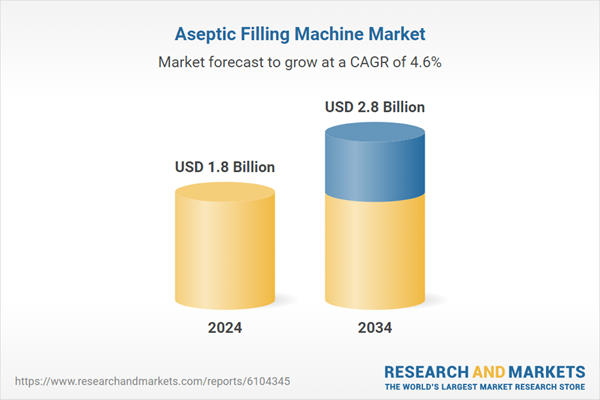Advancements in automation continue to revolutionize the market. Manufacturers are equipping aseptic filling equipment with sophisticated robotics, smart sensors, and intelligent control systems to minimize manual involvement and improve output. The integration of IoT enables predictive maintenance, live tracking, and detailed performance analysis, ensuring reduced downtime and streamlined operations.
With sustainability becoming a top priority, manufacturers are also focusing on eco-friendly solutions, developing machines that minimize material waste and consume less energy. Flexible configurations are being prioritized, with machines now capable of handling diverse product types and container formats while allowing for fast, hassle-free production changeovers.
The standalone aseptic filling machines segment generated USD 1 billion in 2024 and is forecasted to grow at a CAGR of 4.3% during 2025-2034. These machines are favored for their operational efficiency, recent automation enhancements, and ability to accommodate large-scale production in multiple industries. Compact tabletop versions are also gaining momentum among research labs and smaller producers. Their affordability and adaptability make them an excellent fit for low-volume production tasks, such as developing new drugs or running small pilot batches. Their easy integration and versatility support specialized manufacturing needs, making them a popular choice in controlled environments.
The pharmaceutical segment dominated the market in 2024, holding a 39% share, and is expected to grow at a CAGR of 4.9% between 2025 and 2034. Heightened sterility requirements are prompting pharmaceutical manufacturers to invest in highly advanced aseptic systems. Increasing vaccine production and the continued rise of biologics are pushing demand further. The focus remains on optimizing production cycles while ensuring compliance with evolving regulatory frameworks. Pharmaceutical firms are prioritizing scalable, adaptable solutions that meet the rigorous standards of cleanroom manufacturing.
United States Aseptic Filling Machine Market generated USD 430 million in 2024 and secured an 82% share. Growth in the region is being driven by rising demand for packaging solutions that extend product shelf life and meet sterility standards. The growing appetite for longer-lasting packaged goods across the food and beverage sectors is supporting the expansion. Meanwhile, pharmaceutical advancements are pushing for filling systems tailored to specialized formulations. The U.S. market is expected to maintain its strong momentum, backed by a steady wave of technological improvements and expanding use cases across the healthcare and nutrition sectors.
Key industry participants actively shaping the competitive landscape of the Aseptic Filling Machine Market include SIG, Watson-Marlow, Serac, Aseptic Technologies, Tetra Pak, Krones, Romaco, Weiler Engineering, Alfa Laval, Plumat, Aseptic Systems, AST, Groninger, Cytiva, and Dara Pharma. To reinforce their market positions, companies in the aseptic filling machine sector are deploying several strategic initiatives.
Many are increasing investment in automation and digitalization to improve machine precision, reduce operational error, and increase output. Strategic collaborations with pharmaceutical and food companies help tailor product offerings to evolving customer needs. Manufacturers are also focusing on modular machine designs to enhance flexibility and scalability. Sustainability efforts include the development of energy-efficient equipment and waste-reduction features.
Comprehensive Market Analysis and Forecast
- Industry trends, key growth drivers, challenges, future opportunities, and regulatory landscape
- Competitive landscape with Porter’s Five Forces and PESTEL analysis
- Market size, segmentation, and regional forecasts
- In-depth company profiles, business strategies, financial insights, and SWOT analysis
This product will be delivered within 2-4 business days.
Table of Contents
COMPANIES MENTIONED
The companies featured in this aseptic filling machine market report include:- Alfa Laval
- Aseptic Systems
- Aseptic Technologies
- AST
- Cytiva
- Dara Pharma
- Groninger
- Krones
- Plumat
- Romaco
- Serac
- SIG
- Tetra Pak
- Watson-Marlow
- Weiler Engineering
Table Information
| Report Attribute | Details |
|---|---|
| No. of Pages | 220 |
| Published | June 2025 |
| Forecast Period | 2024 - 2034 |
| Estimated Market Value ( USD | $ 1.8 Billion |
| Forecasted Market Value ( USD | $ 2.8 Billion |
| Compound Annual Growth Rate | 4.6% |
| Regions Covered | Global |
| No. of Companies Mentioned | 16 |









